UC Blogs
Those Fascinating Heliconius Butterflies
Those fascinating Heliconius butterflies... Heliconius butterflies will take center stage, so to speak, when James Mallet of Harvard...
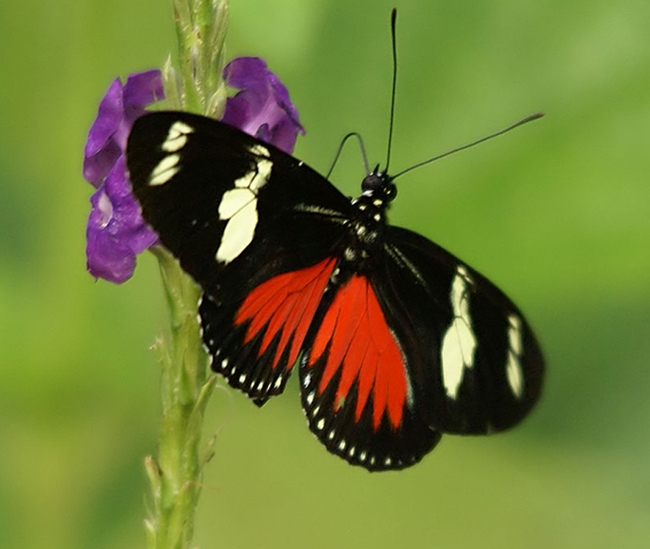
Doris Longwing (Lapus doris viridis) at Puentes Colgantes near Arenal Volcano, Costa Rica. (Photo by Hans Hillewaert, Courtesy of Wikipeda)
Mums the Word
Fall is here and while we feel the growing season has come to an end, we still have many options for both fall color and veggies.
Several years ago a new type of chrysanthemum was bred, called Belgian and Prophets they boasted hundreds of blooms per plant and by using different varieties their blooming season could be extended out to about 6 months.
There are "very early", "early", "mid", "late" season mums. Some early season mums will bloom as early as late June, while the late season bloomers have a limiting factor being frost. Mums can be found in a variety of colors including yellow, white, bronze, purple, and red being the more common colors and now so some hybrids showing bi-colors are showing up such as a yellow with a bronze edge.
Tips & Tricks:
1) 4 inches high on the fourth of July-Years ago my grandmother shared a little garden rhyme with my mom pertaining to mums, she sited "4 inches high on the Fourth of July", cut them back to 4 inches, unless you have some very early bloomers you may wish to leave them alone of cut the back, they will flower again for you in about a month. Keep them blooming longer by removing/grooming spend blossoms. Instead of just taking of the bloom and leaving a bunch of unsightly sticks, when deadheading, prefer to run my forefinger and thumb down the stem about 5 inches and snip or pinch there.
2) Lasso them in, being such abundant and happy growers mums can be over zealous and spread in to what some feel is an unsightly manner. If you wish to keep them more controlled with regard to symmetry, secure a round of twine or green garden tape around them as they reach 1 foot tall.
Often Mums from the florist or from the floral department are given as a hostess gift in a pot or purchased as a treat to add color to the fall entry. Do not hesitate to remove the mums from their pot and plant in the yard when you are done enjoying them as they will give you year after year of happy returns. And if you are really tricky, take a cut stem from an arrangement and stick it in the ground where it will stay moist but not wet, in a few weeks you will have a new plant. Mums must have full sun. while the prophets and the belgiums used to be clearly marked, that seems to have gone by the wayside. I suggest journaling when your mums bloom and make adjustments to their placement and/or propagation accordingly.
Final cutbacks after first killing frost can be done in December or January or when ever they have been blackened or unsightly.
Next month...Winter flower options for your garden, Helebores, Cyclamen, Camelias, Berginia, Brunnera.
Trees Toppled by Space Shuttle Trip
Old. Sick or dying. Creating a havoc on sidewalks. Non-native. Not heritage species. These are some of the reasons given for chopping down 400 trees that once grew along the 12-mile stretch of road traveled by the space shuttle Endeavor on October 12-13. From Los Angeles International Airport to Exposition Park, Eucalyptus (Eucalyptus spp.), Jacaranda (Jacaranda spp.), and others were toppled to make room for the NASA transporter carrying the 75-ton, five-story tall spaceship that measured 122 feet in length and 78 feet wide.
Photos of the gaping spaces and enormous trunks left behind after tree removal can be viewed online at the link listed below. Some trees were more than 80 years old. While I don’t label myself a “greenie,” I am a softie for all things living, especially big and tall, old trees. For me, something seems amiss when a single two-day road trip trumps a survivor with almost a century of growth.
Certainly, the California Science Center expects the shuttle, which CSC president Jeffrey Rudolph called “a historical piece” and “a national treasure,” to draw 800,000 visitors a year. And by 2017, the center plans to build the shuttle’s permanent home—the Samuel Oschin Air and Space Center complete with launch pad and replica fuel tanks and rocket boosters. Also, CSC pledged $500,000 for road improvements and landscaping, promising to replant more trees than were removed.
But I wonder about the arboreal impact on people in communities (Westchester, Inglewood, Los Angeles) now living without wind protection, air filtration and summer shade from those big and tall, old trees. In the dialogue of history, will anybody mention the measure of their worth?
Click below for link to a slide show of post-removal median strip in Inglewood, CA:
http://www.reuters.com/article/2012/09/19/us-usa-space-shuttle-idUSBRE88I01D20120919

Tree removed by space shuttle. (c) LA TIMES
Bohart Museum Open House: Insect Societies!
If you're looking for something to do on Sunday, Nov. 18--something both fun and educational--you'll want to attend the Bohart Museum of...
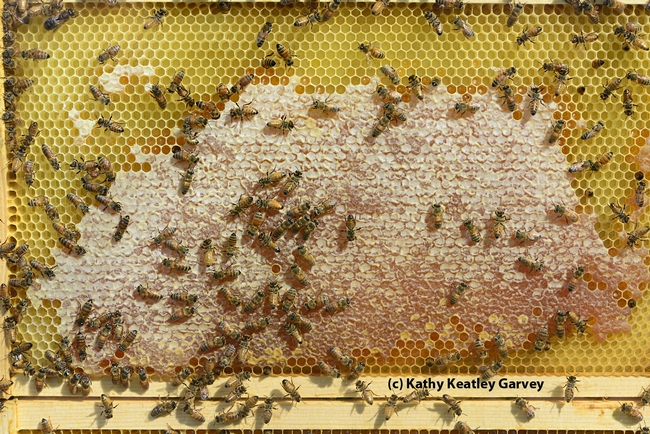
Bee observation hive will be one of the attractions at the Bohart Museum of Entomology open house. (Photo by Kathy Keatley Garvey)
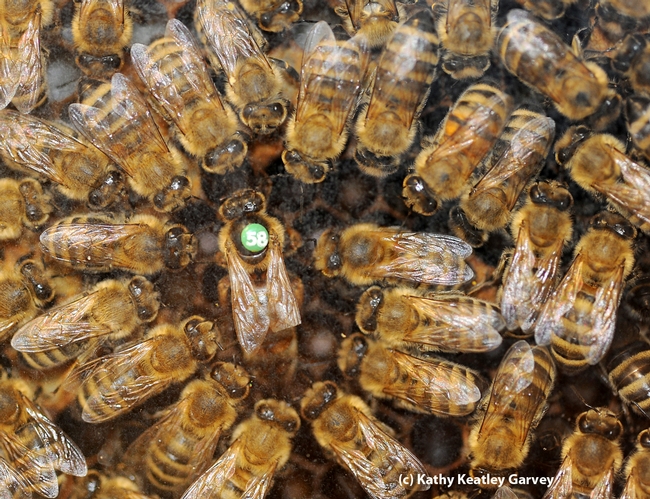
Queen bee and her retinue; as seen through window of bee observation hive. (Photo by Kathy Keatley Garvey)
About those honey bees...
Colony collapse disorder (CCD) has certainly increased public awareness about bees — but also public misinformation about bees in general.
CCD, the mysterious phenomenon characterized by adult bees abandoning the hive, leaving behind the queen bee, immature brood and stored food, surfaced in the winter of 2006. Scientists believe CCD is caused by multiple factors: diseases, viruses, pesticides, pests, malnutrition and stress.
Meanwhile, misinformation about bees continues to surface. Posts on Facebook, Twitter, Pinterest and other social media often caption a syrphid fly as a bee or a syrphid fly as a bumble bee. Magazine and newspaper editors frequently misidentify a syrhpid fly (aka flower fly and hover fly) as a honey bee. Even the cover of the well-respected book, Bees of the World, by Christopher O’Toole and Anthony Raw shows a fly, not a bee. University of Illinois-based entomologist Alex Wild, who received his doctorate from UC Davis, mentioned the error in his Scientific American blog.
So, we asked noted honey bee authority Eric Mussen, UC Cooperative Extension apiculturist based in the UC Davis Department of Entomology: What should the general public know about honey bees? Can you share some basic information? A honey bee primer?
First of all, honey bees are not native to the United States. European colonists introduced them to what is now the United States in 1622. The site: the Jamestown colony in Virginia. Then in 1853, the honey bees were introduced to California. The site: San Jose.
“Honey bees,” Mussen says, “are commercial pollination workhorses, while native bees — mostly solitary — pollinate the native plants of field and forest. Around 250 commercial California beekeepers operate about 500,000 honey bee colonies, approximately one-fifth of the country’s supply. Over 72 percent of commercial crop pollination is conducted in California, and about one-third of our daily diet is dependent upon bee pollination. We also have about 6,000 small-scale or hobby beekeepers, who tend to keep one to five colonies.”
Mussen attributes CCD with “fomenting great media and public interest. It also sparked an increase in the number of small scale beekeepers.”
About 60,000 individuals, including the queen, thousands of worker bees (sterile females) and drones (male bees) comprise a colony in the late spring/summer.
“Up to a thousand drones are present during the mating season,” Mussen says, “but they get evicted at the end of the fall.”
The drones serve one purpose: to mate with a queen. And then they die. When a virgin queen is about 10 days old, she will mate with 12 to 20 drones on one or more mating flights. The queen returns to the hive and begins laying eggs, as many as 2,000 eggs a day.
“Bees are vegetarians and live on pollen and nectar obtained from flowers or extra-floral nectarines,” Mussen says. “A mix of pollens is required to meet honey bee nutritional needs.”
During the active season, a honey bee colony each day requires an acre-equivalent of blooms in order to meet its nutritional needs. Bees store both pollens and honey for winter food. The bees usually forage within five miles of the hive. Nutrition is crucial to a healthy hive.
“Malnutrition impairs the protective physiological systems — particularly the immune system and detoxification system — and leads to less productive and shorter-lived bees,” Mussen says.
The bottom line: “More research is required to find better ways to reduce populations of honey bee parasites, reduce levels of honey bee diseases, and develop beekeeping management practices that prevent excessive losses of honey bee colonies during the year.”
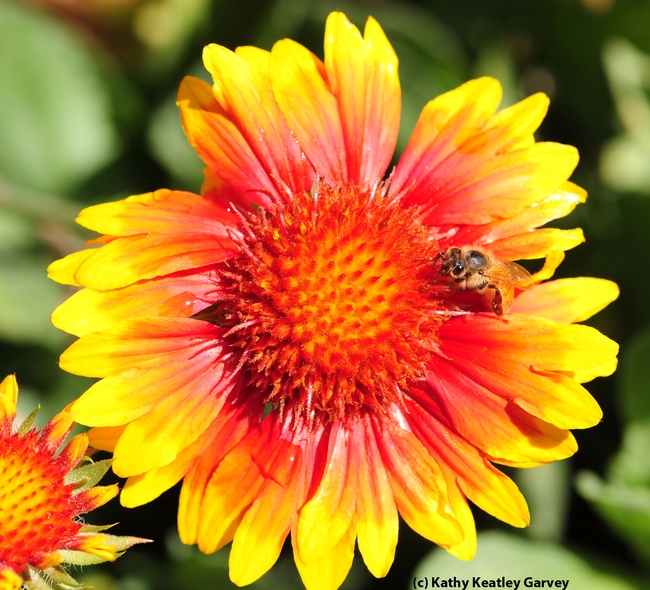
Honey bee on blanket flower, Gaillardia. (Photo by Kathy Keatley Garvey)
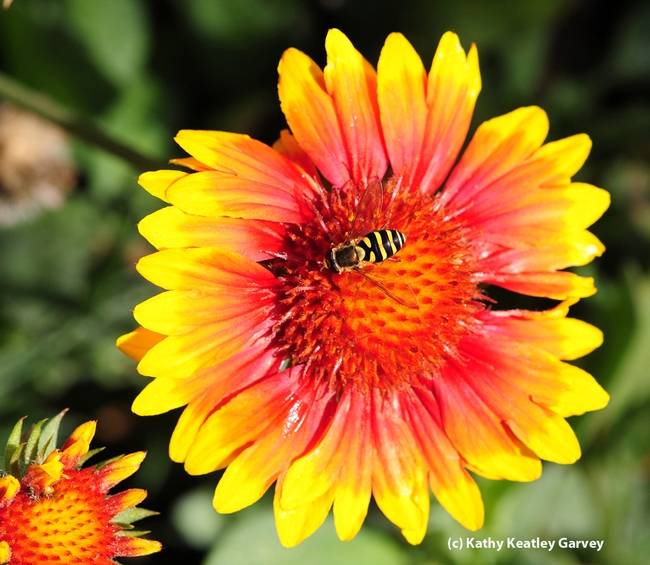
This floral visitor, a syrphid fly, is often mistaken for a honey bee. (Photo by Kathy Keatley Garvey)


